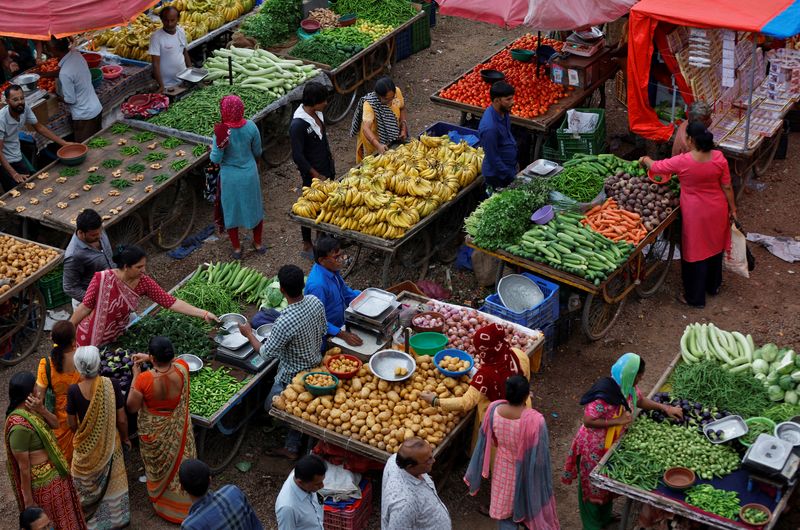By Aftab Ahmed
NEW DELHI (Reuters) - India's retail inflation eased to a three-month low in September on the back of softer vegetable prices, but remained above a target of 4% that the central bank has signalled would be key before easing rates.
Annual retail inflation rose 5.02% in September, down from 6.83% the previous month. A Reuters poll of 66 economists had forecast a rate of 5.50%. Retail inflation in June was 4.81%.
Food inflation, which accounts for nearly half of the overall consumer price basket, rose 6.56% in September as compared with 9.94% in August.
September inflation was below the Reserve Bank of India's (RBI) upper tolerance band of 2%-6%.
But the RBI earlier this month kept its key lending rate steady for a fourth consecutive policy meeting, and emphatically reiterated that it was targeting inflation of 4% and a print of below 6% might not suffice as a condition for easing rates.
Vegetable prices were the key driver in keeping inflation elevated in the previous two months, forcing the government to ban some exports of rice and raise duties for onions.
Vegetable inflation sharply eased to 3.39% in September from 26.14% in the previous month. Cereal inflation in September eased to 10.95% from 11.85% in August. India has banned exports of wheat since last year.
"The central bank is unlikely to shift away from its hawkish rhetoric for as long as there remains a significant risk of a renewed pick-up in food prices," said Thamashi De Silva of Capital Economics.
She added that despite the sharp drop in the headline rate, the food inflation threat was far from over given that India recorded its driest monsoon in five years.
The government also hiked the cooking gas subsidy for low income households to 300 rupees per cylinder from 200 rupees announced in August, to help offset inflation.
In her statement at the Development Committee Plenary of the World Bank in Morocco, Indian Finance Minister Nirmala Sitharaman said on Thursday global and regional uncertainties may keep inflationary pressures elevated in the coming months, warranting greater vigilance by the government and the RBI.
"The government has already taken pre-emptive measures to restrain food inflation which is likely to subside price pressure in the market soon," she said.
Core inflation, which strips out volatile food and energy prices, was estimated to be 4.5%, compared with 4.6%-4.9% in August, according to two economists. The Indian government does not release core inflation figures.
CONFLICT RISKS
Even though oil prices have cooled from last month's highs of over $95 a barrel, they are still hovering above $85 and there are fears that the latest Israeli-Palestinian conflict may add to uncertainties around energy prices.
"This single data point will not really be of importance for the RBI," said Madan Sabnavis, economist at Bank of Baroda.
He said the RBI would assess the impact of the El Nino weather phenomenon on crop output in Asia and the evolution of the Israeli-Palestinian crisis.
Price pressures in some food items continued to persist.

Pulses and product prices rose 16.38% in September, compared with 13.04% in August, while inflation in spices remained sticky at over 23%.
The RBI is expected to keep its repo rate unchanged until June 2024, Sabnavis said.